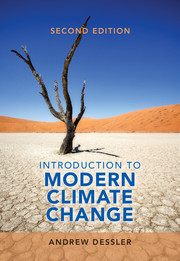Description
Introduction to Modern Climate Change (2nd Ed.)
Author: Dessler Andrew
Language: English
Subject for Introduction to Modern Climate Change:
Introduction to Modern Climate Change (2nd Ed.)
Publication date: 10-2015
273 p. · 17.8x25.4 cm · Paperback
Replaced by new edition: Access to the new edition.
Publication date: 10-2015
273 p. · 17.8x25.4 cm · Paperback
Replaced by new edition: Access to the new edition.
Introduction to Modern Climate Change (2nd Ed.)
Publication date: 09-2015
267 p. · 18.2x26 cm · Hardback
Out of Print
Publication date: 09-2015
267 p. · 18.2x26 cm · Hardback
Out of Print
Description
/li>Contents
/li>Biography
/li>
This is an invaluable textbook for any introductory survey course on the science and policy of climate change, for both non-science majors and introductory science students. The second edition has been thoroughly updated to reflect the most recent science from the latest Intergovernmental Panel on Climate Change reports, and many illustrations include new data. The new edition also reflects advances in the political debate over climate change. Unique amongst textbooks on climate change, it combines an introduction to the science with an introduction to economic and policy issues, and is tightly focused on anthropogenic climate change. It contains the necessary quantitative depth for students to properly understand the science of climate change. It supports students in using algebra to understand simple equations and to solve end-of-chapter problems. Supplementary online resources include a complete set of PowerPoint figures for instructors, solutions to exercises, videos of the author's lectures, and additional computer exercises.
1. An introduction to the climate problem; 2. Is the climate changing?; 3. Radiation and energy balance; 4. A simple climate model; 5. The carbon cycle; 6. Forcing, feedbacks, and climate sensitivity; 7. Why is the climate changing?; 8. Predictions of future climate change; 9. Impacts of climate change; 10. Exponential growth; 11. Fundamentals of climate change policy; 12. Mitigation policies; 13. A brief history of climate science and politics; 14. Putting it together: a long-term policy to address climate change; References; Index.
Andrew Dessler is a climate scientist who studies both the science and politics of climate change. His scientific research revolves around climate feedbacks, in particular how water vapor and clouds act to amplify warming from the carbon dioxide that human activities emit. During the last year of the Clinton Administration, he served as a Senior Policy Analyst in the White House Office of Science and Technology Policy. Based on his research and policy experience, he has authored two books on climate change: this textbook and The Science and Politics of Global Climate Change: A Guide to the Debate, 2nd edition (with Edward Parson, 2010). This textbook won the 2014 American Meteorological Society Louis J. Battan Author's Award. In recognition of his work on outreach, in 2011 he was named a Google Science Communication Fellow. He is presently a Professor of Atmospheric Sciences at Texas A&M University. His educational background includes a BA in physics from Rice University and a PhD in chemistry from Harvard University. He also undertook postdoctoral work at NASA's Goddard Space Flight Center and spent nine years on the research faculty of the University of Maryland.
© 2024 LAVOISIER S.A.S.




